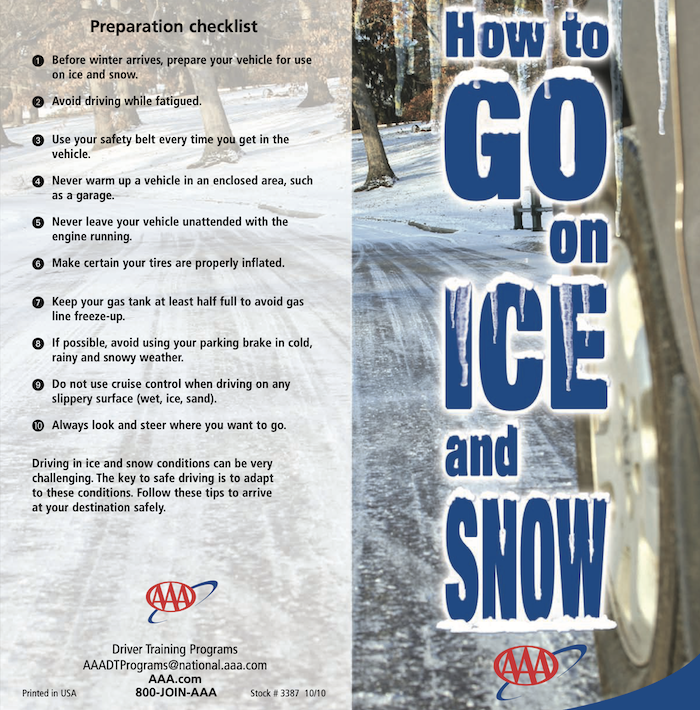Prepare Yourself And Your Vehicle To Prevent Crashes On SoCal Roads During Strong Winter Blast
LOS ANGELES- The National Weather Service is predicting winter weather conditions, including wind, rain, and snow, for parts of Southern California, with a blizzard warning beginning Friday morning for the local mountains. Snow could fall as low as at 1,000 to 1,500 feet elevation, impacting some Southern California streets in foothill communities. The Automobile Club of Southern California reminds drivers that traveling in winter conditions, such as snow and ice, can be challenging and dangerous, especially for those who are not accustomed to driving in freezing temperatures.
During winter weather, drivers are encouraged to stay tuned to weather forecasts prior to road trips and before driving in rural areas. Drivers should delay trips when especially bad weather is expected and follow all directions from local authorities and law enforcement. Before departing, people should let others know their intended route, destination, and estimated time of arrival.
Preparing your vehicle for driving in bad weather
- Make sure your tires are in good condition and properly inflated, and that you have chains if you might be traveling through a snowy area. To check tire tread depth, place an upside-down quarter (not a penny) in a tire tread. If you can see the top of George’s head, it’s time to replace the tire.
- Clear all snow and ice from the vehicle’s windows, roof, hood, trunk lid and any other covered areas. This will reduce risk because it increases your visibility. Additionally, drivers around you won’t be blinded by snow blowing off your vehicle.
- Use an ice scraper to remove snow and ice from your windshield and all windows, including side and rear windows. This will improve your ability to see other roadway users that may move into your path of travel.
- To increase your ability to see clearly, clean the outside and inside of your windshield at least once a week. Frequent cleaning is even more important if you smoke.
- Keep your car’s windshield and rear-window defrosters in good working condition.
- Keep your windshield wiper blades fresh. Many drivers change them every six months, especially before driving in bad weather.
On the road
- If you must travel and there is a wind advisory along your route, keep extra distance from high-profile vehicles that could overturn. Be especially cautious on bridges and overpasses, as well as open areas where the wind is not obstructed. Watch for objects that could suddenly blow onto the road in front of you, but avoid slamming on your brakes, which could cause you to lose control of your vehicle.
- Make sure your headlights are on so other vehicle drivers can easily see you.
- Watch out for emergency workers helping stranded drivers at the roadside (EMS, police, firefighters, tow truck operators and CalTrans workers). Move out of the lane closest to them, if safe to do so. If not, slow way down.
- Keep both hands on the wheel at all times.
- Reduce your speed and leave plenty of room to stop. You should allow at least three times more space than usual between you and the vehicle in front of you.
- Brake gently to avoid skidding.
- Do not use cruise control on any wet, snow-covered, or icy roads.
- Be aware of possible icy roads. Be especially careful on bridges and overpasses, which freeze sooner than roads. Even at temperatures above freezing, if conditions are wet, you might encounter ice in shady areas or on exposed roadways like bridges.
- Be careful on infrequently traveled roads, which may not be cleared as often as other roads.
Leaving the roadway
- If you must pull off the road, wait for conditions to improve and pull off the road as far as you can, preferably past the end of a guardrail.
- It is best to pull into a rest area or parking lot, rather than on the road’s shoulder.
Know When to Brake and When to Steer
- Some driving situations require abrupt action to avoid a crash or collision and in winter conditions the decision to steer or brake can have very different outcomes. When traveling more than 25 mph, the Auto Club recommends steering over braking to avoid a collision in winter-like conditions, as less distance is required to steer around an object than to brake to a stop. In slick conditions, sudden braking can lead to loss of vehicle control.
- However, sometimes steering is not an option. Braking on slippery surfaces requires you to look further ahead and increase following and stopping distances. Plan stopping distances as early as possible and always look 20-30 seconds ahead of your vehicle to ensure you have time and space to stop safely.
Stay in Control Through a Skid
- Even careful and experienced drivers can skid on slippery surfaces. When a vehicle begins to skid, it’s important not to panic.
- Continue to look and steer in the direction you want the car to go.
- Avoid slamming on the brakes as this will further upset the vehicle’s balance and make it harder to control.
Additional Winter Driving Safety Tips from the Auto Club:
- Use your seatbelt every time you get in the vehicle.
- Never warm up a vehicle in an enclosed area, such as a garage.
- Make sure the exhaust pipe isn’t clogged with snow, ice or mud. A blocked exhaust could cause deadly carbon monoxide gas to leak into the passenger compartment with the engine running.
- Never leave your vehicle unattended with the engine running.
- Keep your gas tank at least half full to avoid gas line freeze-up.
Additional information on driving in winter conditions can be found at How to Go on Ice and Snow.




















